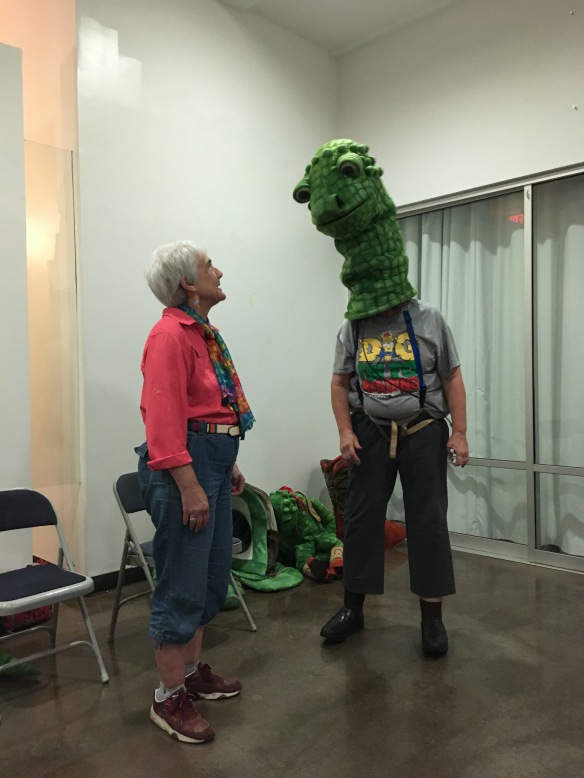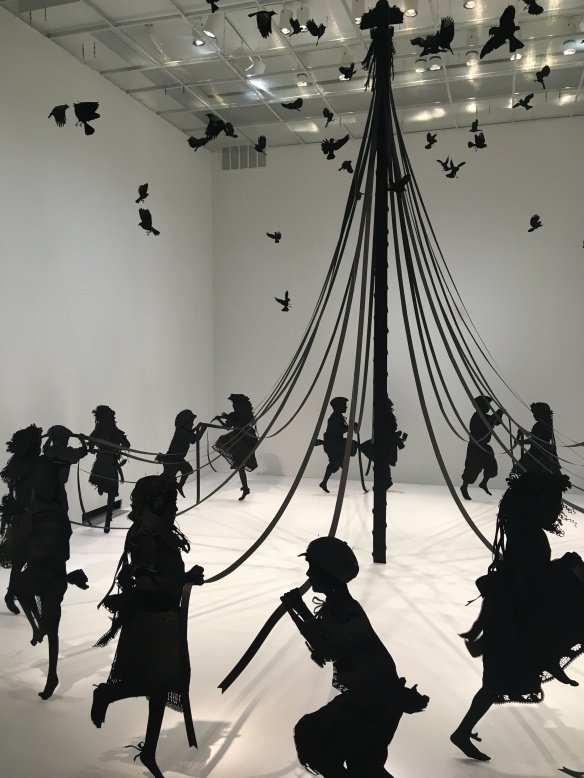At our company meeting last summer, when I asked if there were any projects we wanted to start for the upcoming year, Patricia Germann mentioned that she’d like to curate a lecture series on puppetry, featuring local artists. She had noticed that we often had lots of people come up to us at our shows looking for more information about puppetry and puppet-building and realized that there might be an audience for a free event bringing artists and spectators together. One year later, we’ve had six great conversations with a wide range of puppet artists. Here’s Patricia, talking a little bit more about what has turned into The Puppet Lobby.

Michelle Valeri and Ingrid Crepeau, Genna Beth Davidson and Hamida Khatri presenting at the Puppet Lobby in 2017-2018.
Cecilia Cackley: When did you get the idea for The Puppet Lobby?
Patricia German: I’d been thinking about an event series like this for about a year before we actually started it. DC is such a networking town, and I often come across events like this in so many other industries. Creating a space for artists to connect about puppet design, building, and performance felt like we were filling a gap.
CC: Has it gone the way you had hoped when you started? Is there anything you would change?
PG: I’m really happy with this first year, and the response from the community has been great. We’ve had so many incredible speakers willing to share their work, and we’ve covered such a breadth of topics — stop motion, hand puppets, full body costumes, installation pieces… It’s really exciting to see how much talent we have in the area, both in DC and in Baltimore. (And people from Baltimore have been willing to drive into DC on a weeknight for this! For me, that’s been wonderfully unexpected.)
I think the speakers have kind of surprised themselves with how much they have to share. When we initially asked for a 15- to 20-minute presentation, some speakers were worried it was going to be a stretch to fill that much time. But once we got going with the series, it started feeling like even at 20 minutes we were cutting off some great conversations. So over the year, we started setting aside more time for the featured speaker, rather than trying to fill out the agenda with several different topics. I think that’s worked well.
CC: What are some of your favorite moments from this year’s conversations?
PG: Ha! Each one has been different in its own way. I loved playing around with Alex Vernon’s Fettig Project puppet mechanics. They were so expressive, and I hadn’t seen anything like that before. Hearing more of the story about Hamida Khatri’s mom as the inspiration for her short film was really great. And pretty much any part of Ingrid Crepeau’s presentation could be a favorite moment. She’s a hoot, and had so many great design tips to share!
CC: If you could invite any puppeteer to visit The Puppet Lobby, who would it be and why?
PG: Nicholas Mahon, who created the puppets for the Olympic Opening Ceremonies this past winter in Pyeongchang. I’d love to hear about the process of creating those characters, actually getting them over to South Korea, and incorporating them into such a huge event with so many elements. Also, I’d love to work on an Olympics opening ceremony, so I’m curious to hear how he got the gig!
CC: What can we expect to see in the upcoming year from The Puppet Lobby?
PG: More puppets! More lobby! I have some ideas for panel discussions around a specific theme, like bringing together the three artists from this season who we discovered have all built large-scale dinosaur puppets. And for the more typical presentations, we’re continuing to reach out to artists across DC and Baltimore. We’re hoping that with a little more lead time, some of the speakers who couldn’t make it last year will be able to join us in 2018-19. But part of the idea of The Puppet Lobby is to connect artists who don’t normally work together — so if you have some great project you’ve been working on that you want to share with this community, send us an email and let us know!



















